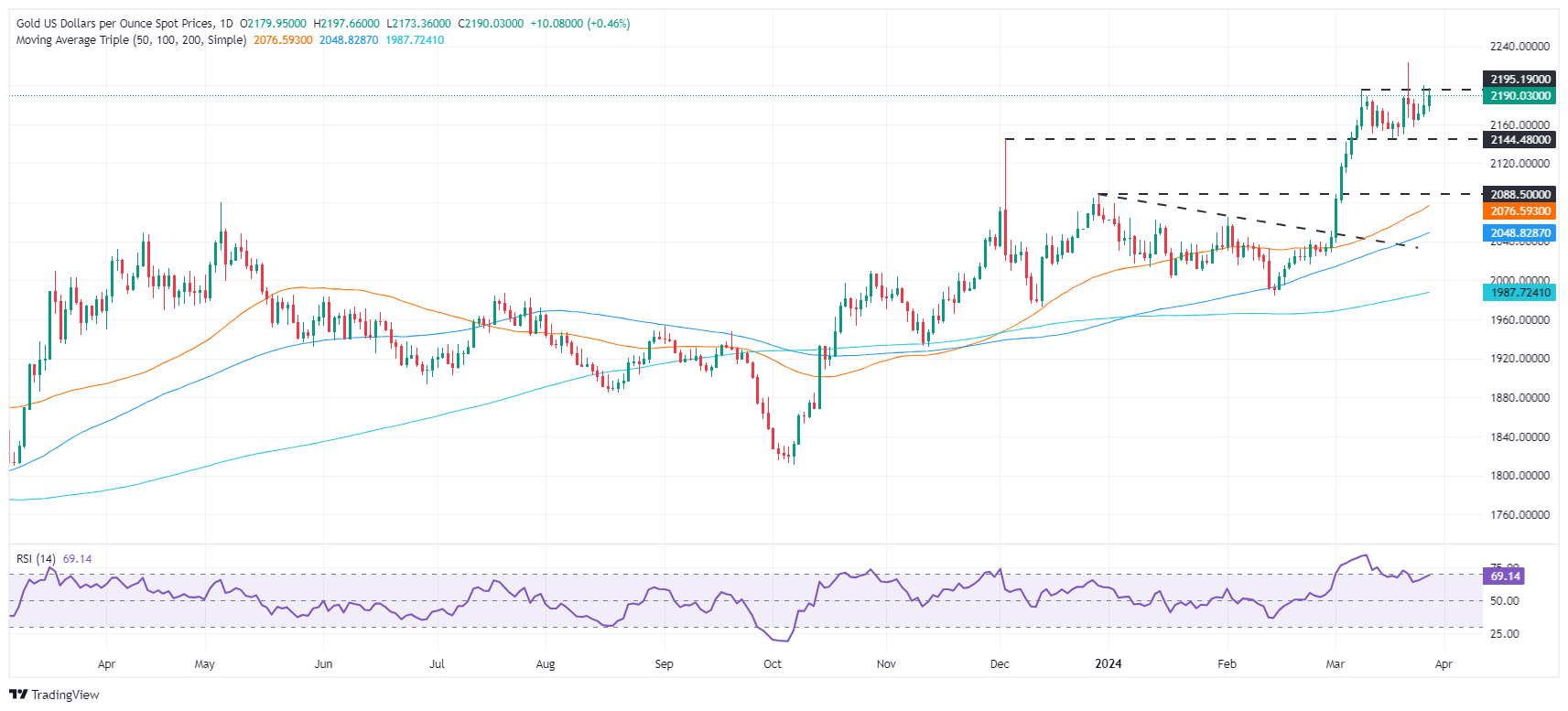Gold nears $2,200 as Fed rate cut speculation fuels rally
- Gold prices ascend, aiming for the $2,200 mark, buoyed by expectations of a Fed rate cut.
- A dip in US Treasury yields to 4.19%, slight decrease in real yields enhance Gold's appeal as a safe-haven.
- Traders eyed Fed Governor Christopher Waller's speech and upcoming core PCE data for potential cues on monetary policy direction.
Gold prices climbed steadily during the North American session on Wednesday as buyers targeted the $2,200 figure. A scarce economic calendar in the United States (US) prompted investors to buy the yellow metal on the back of rising speculation of a rate cut in June by the Federal Reserve (Fed). At the time of writing, the XAU/USD trades at $2,192, posting gains of 0.63% or $13.
The fall of US Treasury yields underpins the price of the non-yielding metal. The US 10-year benchmark note rate sits at 4.19%, down four basis points. Consequently, US real yields edged lower from 1.914% on Tuesday to 1.87% as of the time of writing, a headwind for the Greenback.
The US Dollar Index (DXY), which measures the Greenback’s performance against the other six currencies, trades flat at 104.30, a headwind for the non-yielding metal.
The US economic docket is scarce, with just a speech by Fed Governor Christopher Waller at around 22:00 GMT. The highlight of the week will be the release of the Fed’s preferred gauge for inflation, the core Personal Consumption Expenditures (PCE) report, on Friday.
In addition, the current week’s economic calendar will feature University of Michigan Consumer Sentiment, Initial Jobless Claims, and the release of the final reading of the Gross Domestic Product (GDP) on Thursday.
Daily digest market movers: Gold advances as US real yields tumble
- Money market traders predict a 70% chance that the Federal Reserve will slash rates by a quarter of a percentage point in June, setting the federal funds rate (FFR) at 5.00% - 5.25%.
- Federal Reserve officials remain set to cut rates, but there’s division among the Federal Open Market Committee (FOMC) board. Atlanta Fed President Raphael Bostic noted that he expects one rate cut instead of two in 2024. Meanwhile, Fed Governor Lisa Cook echoed Bostic’s comments and added that easing policy too soon increases the risk of inflation becoming entrenched.
- Chicago Fed President Austan Goolsbee remains dovish, expecting three cuts, though he said he needs more evidence of inflation dropping.
- Gold traders await the release of the Federal Reserve’s preferred gauge for inflation, the Core Personal Consumption Expenditure (PCE) Price Index. The Index is estimated to grow 2.8% YoY in February, with monthly figures expected to slow from 0.4% to 0.3% MoM.
Technical analysis: Gold price pushes above $2,190 with buyers targeting all-time high
Gold price resumed its uptrend on Wednesday after diving to a weekly low of $2,163 on Monday, capitalized by buyers, which lifted the yellow metal prices near the $2,200 figure. The Relative Strength Index (RSI), aiming higher, suggests that bullish momentum builds, If traders clear the aforementioned level, a test of the all-time high at $2,223 is on the cards.
On the flip side, if sellers push prices below the December 4 high, which turned support at $2,146, that could exacerbate a sell-off and send XAU/USD prices diving toward $2,100. The next support would be the December 28 high, which is $2,088.
Gold FAQs
Gold has played a key role in human’s history as it has been widely used as a store of value and medium of exchange. Currently, apart from its shine and usage for jewelry, the precious metal is widely seen as a safe-haven asset, meaning that it is considered a good investment during turbulent times. Gold is also widely seen as a hedge against inflation and against depreciating currencies as it doesn’t rely on any specific issuer or government.
Central banks are the biggest Gold holders. In their aim to support their currencies in turbulent times, central banks tend to diversify their reserves and buy Gold to improve the perceived strength of the economy and the currency. High Gold reserves can be a source of trust for a country’s solvency. Central banks added 1,136 tonnes of Gold worth around $70 billion to their reserves in 2022, according to data from the World Gold Council. This is the highest yearly purchase since records began. Central banks from emerging economies such as China, India and Turkey are quickly increasing their Gold reserves.
Gold has an inverse correlation with the US Dollar and US Treasuries, which are both major reserve and safe-haven assets. When the Dollar depreciates, Gold tends to rise, enabling investors and central banks to diversify their assets in turbulent times. Gold is also inversely correlated with risk assets. A rally in the stock market tends to weaken Gold price, while sell-offs in riskier markets tend to favor the precious metal.
The price can move due to a wide range of factors. Geopolitical instability or fears of a deep recession can quickly make Gold price escalate due to its safe-haven status. As a yield-less asset, Gold tends to rise with lower interest rates, while higher cost of money usually weighs down on the yellow metal. Still, most moves depend on how the US Dollar (USD) behaves as the asset is priced in dollars (XAU/USD). A strong Dollar tends to keep the price of Gold controlled, whereas a weaker Dollar is likely to push Gold prices up.







